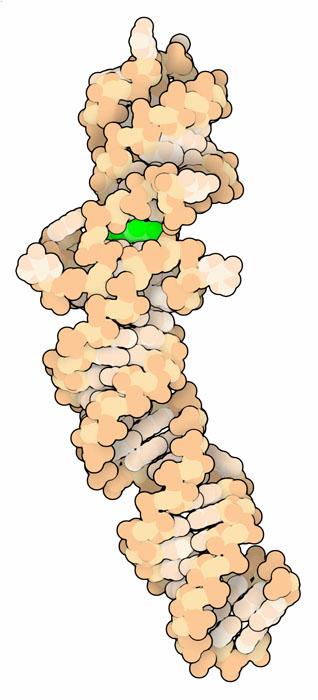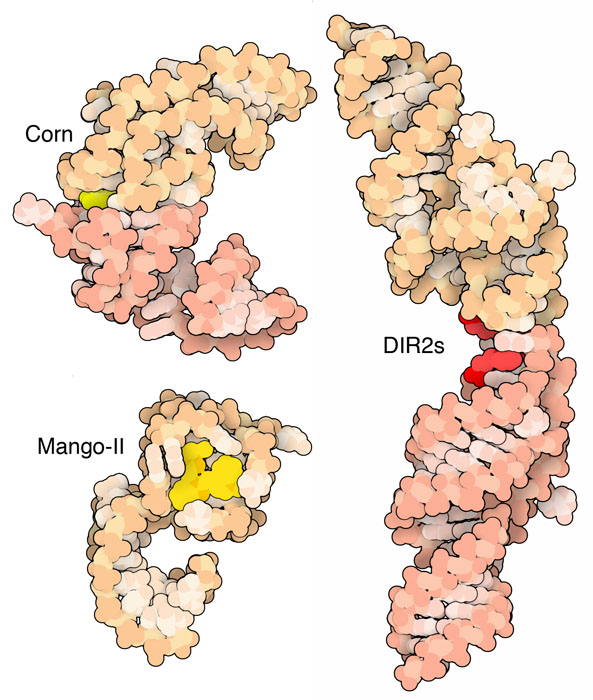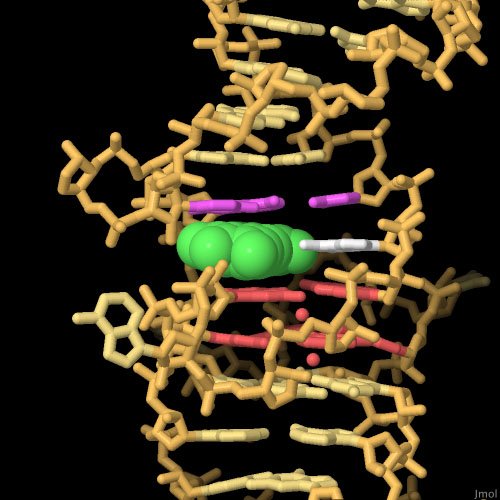Molecule of the Month: Fluorescent RNA Aptamers
RNA aptamers are being engineered to track molecules inside living cells

Evolving Aptamers
Structure Challenges

Aptamer Palette
Exploring the Structure
Spinach Fluorescent RNA Aptamer

The Spinach aptamer surrounds its fluorophore, forming a rigid pocket that enhances the fluorescence of the molecule. One face of the fluorophore is packed against a G-quadruplex (colored pink), and the other face is covered by a nucleotide base triplet (colored magenta). An additional guanine (white) interacts with the edge of the fluorophore and positions it in the pocket. To explore this structure in more detail, click on the image for an interactive JSmol.
Topics for Further Discussion
- To see the packing of spinach aptamers in the crystal lattice, choose 3D View: Structure at the main RCSB site and choose the options for Unit Cell or Supercell in the Assembly menu.
- Most of these aptamers have a G-quadruplex that packs against the fluorophore—as you’re exploring these structures, try to follow how the RNA chain folds to position the four guanines in the proper orientation.
Related PDB-101 Resources
- Browse Nanotechnology
- Browse Bioluminescence and Fluorescence
- Browse Nucleic Acids
References
- Trachman, R. J., Truong, L., Ferré-D’Amaré, A. R. (2017) Structural principles of fluorescent RNA aptamers. Trends Pharmacol. Sci. 38: 928-939.
- 6db8: Shelke, S.A., Shao, Y., Laski, A., Koirala, D., Weissman, B.P., Fuller, J.R., Tan, X., Constantin, T.P., Waggoner, A.S., Bruchez, M.P., Armitage, B.A., Piccirilli, J.A. (2018) Structural basis for activation of fluorogenic dyes by an RNA aptamer lacking a G-quadruplex motif. Nat. Commun 9: 4542-4542.
- 6c63: Trachman 3rd., R.J., Abdolahzadeh, A., Andreoni, A., Cojocaru, R., Knutson, J.R., Ryckelynck, M., Unrau, P.J., Ferré-D'Amaré, A.R. (2018) Crystal structures of the Mango-II RNA aptamer reveal heterogeneous fluorophore binding and guide engineering of variants with improved selectivity and brightness. Biochemistry 57: 3544-3548.
- 5bjp: Warner, K.D., Sjekloca, L., Song, W., Filonov, G.S., Jaffrey, S.R., Ferré-D'Amaré, A.R. (2017) A homodimer interface without base pairs in an RNA mimic of red fluorescent protein. Nat. Chem. Biol. 13: 1195-1201.
- 4kzd: Huang, H., Suslov, N.B., Li, N.S., Shelke, S.A., Evans, M.E., Koldobskaya, Y., Rice, P.A., Piccirilli, J.A. (2014) A G-quadruplex-containing RNA activates fluorescence in a GFP-like fluorophore. Nat. Chem. Biol. 10: 686-691.
- 4ts2: Warner, K.D., Chen, M.C., Song, W., Strack, R.L., Thorn, A., Jaffrey, S.R., Ferré-D'Amaré, A.R. (2014) Structural basis for activity of highly efficient RNA mimics of green fluorescent protein. Nat. Struct. Mol. Biol. 21: 658-663.
January 2019, David Goodsell
http://doi.org/10.2210/rcsb_pdb/mom_2019_1


